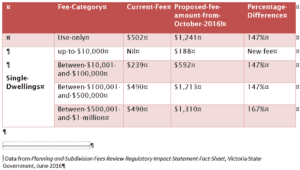01 Aug Planning Application Fees Set to Rise

** Update: The new planning fees have now been introduced and came into affect on the 13th October 2016. More details are available here **
The State Government has been reviewing the Planning and Subdivision Fees that are payable when lodging a planning or subdivision application. A draft fee structure was prepared and made available for public comment. Now the proposal is with the Minister and It is anticipated that the new fees will be introduced in October this year.
The purpose of the changes to the fees is to capture full cost recovery for most planning and subdivision applications. As Planning and Subdivision Fees have not been consistently reviewed since they were introduced in 2000 and were last increased in 2009, fees will generally be going up quite considerably.

The increase in fees is variable. Some things, such as the cost of planning certificates will not see a large increase, while other things such as planning scheme amendments will see an increase of 500% or more. There are also a number of new fee categories that will be added to the list, including a fee for development associated with a single dwelling with an estimated cost of less than $10,000 as well as separate fees for the fast track VicSmart applications (find out more about VicSmart applications here). In total the State Government is expected that total revenue collected from the fees will be around $80-90 million a year, an increase of at least double what is currently collected. This revenue will be collected by individual Councils.
The new fee structure is to be expressed as fee units. The fee units will be annually indexed by the Treasurer under the Monetary Units Act 2004. This will allow for the fees to increase yearly.
While fees are set to rise, those relating to most single dwellings and low value developments have been set at a lower rate that will not result in full cost recovery. This has been done to support work carried out by home owners and small business owners. While this might ease the burden on home owners and small business owners a bit, as the table below shows, the fees will still be set to rise quite a bit. The Government also considered the potential for higher costs to result in small scale work being carried out without a permit, so I imagine this is something they will monitor closely once the new fees are introduced..

The size of fees for developments of over $50 million and for planning scheme amendments will see a huge increase. The fee for developments over $50 million will increase from $16,130 to $54,282 and planning amendment fees will increase by between 500% and 1330%. To manage this significant fee increase, it is proposed that the fees in these categories will be set at 50% value for the first 12 months of the new regulations. After this time the fees will be increased to the full amounts.
The cost to amend planning permits and applications is also set to increase. The fees associated with amending both an existing application that has not been decided yet as well as an approved planning permit will now be based on the original cost of the development (plus the difference if the amendment moves the project to a new fee class). Previously the fee was either a flat fee or based on the cost of the amendments. The changes will mean that even minor changes to a large project will bear a considerable cost now. This has implications in making sure changes to applications or approved projects are minimised and may increase the need for additional pre-application advice before lodging an application to ensure that costly amendments don’t have to be undertaken later.
Once the fee regulations are introduced, they will apply immediately. This means that any current applications that require a further fee (such as for an amendment to the application) will be charged the new fee.
After the fees are introduced an evaluation must be conducted within 5 years. The State Government will use planning permit data that will be collected as well as seeking views from a range of stakeholders on the impacts of the new fees. I will certainly be waiting to see what impacts it has on the industry.
I know many of my clients would be satisfied with additional fees if it resulted in faster processing times for planning applications, so here’s hoping that the additional revenue raised will be used to streamline processes and employ additional staff so that we will see significantly reduced waiting times on applications.
You can read more information on the proposed fees here, including a table showing what the proposed fees will be in October. If you have any questions about fees or are looking to beat the fee increase, you can contact the office for some preliminary advice.

